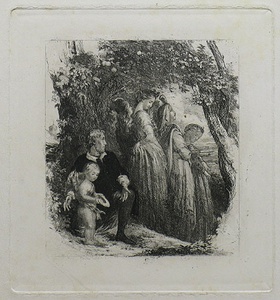| Notes |
Richard Redgrave (1804-1888) was a British draughtsman, painter and printmaker. He is best-known for his genre paintings including The Sempstress (1844), Country Cousins (1847-48) and The Outcast (1851) Whilst working for his father's manufacturing company, Redgrave often visited the British Museum to make drawings of the marbles. His work The River Brent, near Hanwell of 1825, saw him admitted to the Royal Academy the following year. In 1830, Redgrave left his father's company to work as a full-time art teacher. In 1840 Redgrave was elected an Associate of the Royal Academy, and later became an Academician in 1851. In 1847 Redgrave taught at the Government School of Design (now the Royal College of Art) as a lecturer in Botany. He was promoted to Head Teacher the following year and became Art Superintendant in 1852. He was Inspector-General for Art at the Science and Art Department in 1857, and Art Director of the South Kensington Museum (now the Victoria and Albert Museum). Redgrave was incredibly important in the establishment of the museum, and was responsible for securing the art collections of Richard Sheepshanks and Richard Ellison. He received the cross of the Legion of Honour after serving on the executive committee of the British section of the Paris Exhibition of 1855. As Surveyor of the Queen's Pictures, between 1855 and 1880, Redgrave produced a thirty-four volume catalogue detailing the paintings at Windsor Castle, Buckingham Palace, Hampton Court and other royal residences. With his brother Samuel, Redgrave wrote the acclaimed A Century of Painters of the English School (1866).
|

